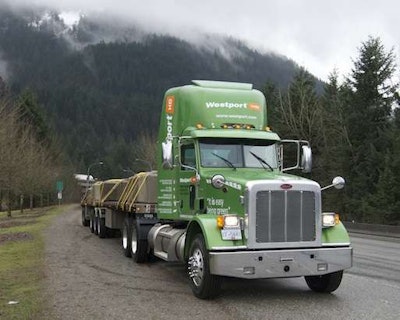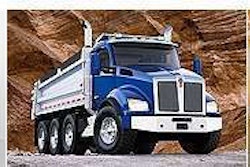 Westport calls this 2012 Peterbilt 367 “Kermit.” The truck’s equipped with a Westport 15-liter engine, a 475-horsepower high-pressure direct-injection natural gas engine.
Westport calls this 2012 Peterbilt 367 “Kermit.” The truck’s equipped with a Westport 15-liter engine, a 475-horsepower high-pressure direct-injection natural gas engine.Natural gas truck engines are on everyone’s lips these days, and Westport is clearly the technology leader in this field. The company is probably best known today for its partnership with Cummins and the resulting ISL 8.9G – and the soon-to-be-unveiled ISX12G – natural gas engines.
But the company also produces its own proprietary line of natural gas engines, including the Westport 15L, a 475-horsepower high-pressure direct-injection natural gas engine. I was in Vancouver to see how it performs, and this would not be your typical test drive. It would be lugging 140,000-pound flatbed doubles – a “bi-train,” as the Canadians call it – into the Cascade Mountains.
As with the Cummins-Westport family of natural gas engines, the Westport 15L uses a Cummins “donor” engine as its foundation. Once modified, these engines are considered entirely Westport products. Last year, the company began repainting its engines orange and will brand them “Westport” this year. Cummins-Westport engines will continue to sport Cummins red.
While Cummins-Westport engines are spark-ignited, Westport 15L engines rely on a small shot of diesel fuel to initiate combustion. The company says that out of the total fuel capacity on a Westport 15L-powered truck, 95 percent of diesel fuel is replaced by liquefied natural gas, with 5 percent of diesel remaining to initiate combustion. This allows fleets to employ natural gas engines in severe-service applications because compression-ignited natural gas engines do not run as hot as spark-ignited ones, says Stephen Ptucha, director of product management for Westport. So there’s less risk of engine overheating in tough driving conditions. Additionally, fuel costs are reduced drastically because natural gas prices are still relatively low.
My drive started at Vedder Transport in Abbotsford, British Columbia. Vice president Fred Zweep told me how Vedder is running 50 Peterbilt 386 and 367 tractors with 475-horsepower Westport 15L engines on tough drives into the Cascades. The trucks have accumulated more than 3 million miles in a little over a year, with only a few fuel injector failures hampering operations.
“Kermit” is what the folks at Westport call their 2012 Peterbilt 367 daycab, paying homage to the famous green Muppet frog. The truck’s muted neon green is what Peterbilt uses to showcase its environmentally friendly alternative fuel vehicles.
The Westport 15L doesn’t look all that different from a conventional diesel. Granted, there are a few component and routing differences, but you’d have to be an expert technician – or at least have two engines side by side – to spot those changes at a glance.
Things are a bit different on the chassis. Kermit is equipped with two large 120-gallon LNG tanks, and there’s a 50-gallon diesel tank and a 9-gallon diesel exhaust fluid tank. LNG typically has a temperature of about -260 degrees Fahrenheit when produced at the liquefaction plant, and about -220 degrees when it goes into the truck tank, so special insulation is required. But again, to the untrained eye, the overall look is not too different from a conventional tractor-trailer tank configuration – a testament to Westport’s integration design efforts.
Kermit’s first impression: The Westport 15L engine is noticeably quieter than a conventional diesel, both at idle and at road speeds. More importantly, I can’t discern any difference from a diesel in terms of torque when launching the truck; acceleration is smooth with predicable shift points. Even with twice the weight I’m accustomed to pulling, getting Kermit up and moving is no sweat for this natural gas engine.
That impression holds true as the drive to Boston Bar progresses. Any doubts concerning the ability of a natural gas engine to perform in a severe-service application are cast aside quickly. The engine’s performance is a nonevent compared to diesel. In terms of every considerable metric, this engine performed just as well.
I pulled out of Abbotsford heading East on Trans-Canadian Highway 1, running straight through the pancake-flat Fraser Valley. Once at speed, Kermit and the natural gas engine weren’t sweating a bit.
I always find Peterbilts a delight to drive, given their great visibility and superior handling characteristics, and both features were a bonus given the traffic around us. But I was more delighted to discover that there was plenty of oomph available from the Westport 15L if I decided to ease left and pass. Putting my foot to the floor brought an instant response and impressive acceleration, considering the payload.
Things got more interesting when I turned north onto Trans-Canadian Highway 1 leading into the Cascades, a narrow two-lane affair cut into the mountainside. Its stunning vistas are offset by long tough grades and treacherous switchbacks, but the HPDI Westport 15L had more than enough power and flexibility to handle these steep grades.
I was unprepared for how rapidly a bi-train can bleed off your speed on a steep grade. Forget missing a shift; in this situation, simply mistiming a shift – even if you hit it perfectly – can have a disastrous consequence when it comes to speed management in those mountains. The Vedder guys definitely get a tip of my hat for doing it with such consummate skill.
One of a driver’s most fundamental tasks is harnessing power and torque in the most effective way to make a rig respond effectively in conditions such as these. This test showed me that no driver needs to be concerned about starting out with a power deficit when using a natural gas engine – even in severe-service high-capacity hauls.










